by Salvatore Ceccarelli
Science has recently begun associating the decline of biodiversity with the increase of inflammatory diseases. These range from inflammatory bowel disease, to ulcerative colitis, to cardiovascular disorders, to various liver diseases and to many types of cancer (1). This increase in the frequency of inflammatory diseases has been associated with a decrease in our immune defences (1). Even more recently, the microbiome – namely the complex of bacteria, viruses, fungi, yeasts and protozoa that is in our intestine – sometimes called microbiota (2) – has been associated with our immune system and then with the possibility of contracting inflammatory diseases (3).
The microbiome, which weighs an average of two kilograms – consider that the human brain weighs an average of one and a half kilograms – plays a number of important functions, from the synthesis of vitamins and essential amino acids, to the breakdown of what has not been digested in the upper intestinal tract. Some of the products of these activities represent an important energy source for intestinal wall cells and contribute to intestinal immunity.
The diet strongly influences the microbiome, and a change in the diet changes its composition in just 24 hours; it takes 48 hours, after changing the diet again, before the microbiome returns to the initial conditions (4).
Research published in November 2017 (5) showed that patients suffering from melanoma and capable of responding to immune therapy had a microbiome that differed both by composition and by diversity from patients who did not respond. The research concluded that the composition and the diversity of the microbiome are important in determining antitumor immunity. The response of laboratory mice that had received a fecal transplant from human patients who had responded to the therapy supported the results. Fecal transplantation involves transferring the microbiome from a healthy patient to a patient with a disease and is becoming a widespread practice for the treatment of diseases that do not respond to antibiotics (5).
Diet and health, including mental health
The microbiome also appears to be involved in several neuropsychiatric disorders such as depression, schizophrenia, autism, anxiety, and stress response (6). This is likely due to the damage that inflammatory processes cause to myelin, the sheath surrounding the neurons, thus altering the normal transmission of nerve impulses.
Given the important roles of the microbiome on the one hand, and the fact it is so strongly and rapidly influenced by diet on the other, it is understandable that there have been many studies on the effect of various diets (western, omnivorous, mediterranean, vegetarian, vegan etc.) on the composition and the diversity of the microbiome itself (7). Recent results demonstrate that gut microbiome composition is shaped predominantly by environmental factors (diet and lifestyle) and that the microbiome is not significantly associated with the genetic ancestry (8).
The diet also links environmental and human health. Rising incomes and urbanization are driving a global dietary transition in which traditional diets are replaced by diets higher in refined sugars, refined fats, oils and meats. By 2050 these dietary trends, if unchecked, would be a major contributor to an estimated 80 per cent increase in global agricultural greenhouse gas emissions from food production and to global land clearing. Moreover, these dietary shifts are greatly increasing the incidence of type II diabetes, coronary heart disease and other chronic non-communicable diseases that lower global life expectancies (9).
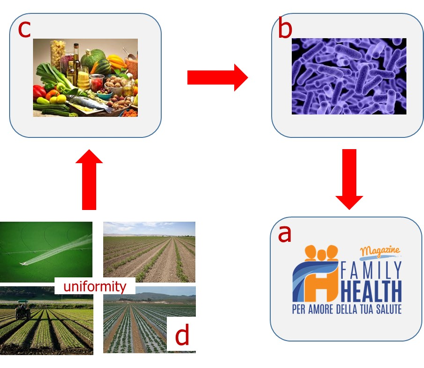
The opinions of nutritionists looking at the effects of various diets do not always agree, but what all nutritionists seem to agree on is that diet diversity is of paramount importance for having a healthy microbiome (10).
Diversity and Uniformity
And here the problems begin. How can we have a diversified diet if 60% of our calories come from just three crops, namely wheat, rice and maize (11)? And how do we diversify our food if almost all the food we eat is produced from varieties that, to be legally marketed – for their products to be legally found in supermarkets – must be registered in a catalogue called a varietal register, and that to be registered they should be uniform, stable and distinct?
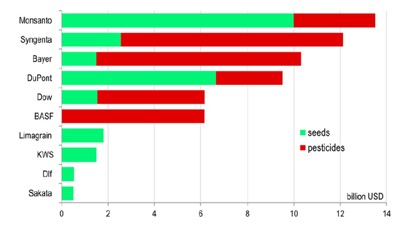
Between the need to diversify our diet and the uniformity imposed by law on crops there is an obvious contradiction. In addition, there is also an obvious contradiction between uniformity and stability on the one hand and the need to adapt crops to climate change on the other.
Seeds, Food and Health
The situation gets even worse when we consider that alongside a food oligopoly, there is also a seed oligopoly (from which all the food comes directly or indirectly) as the world seed market, a market worth billions of dollars is about 55% (2016 data) in the hands of a five large multinational corporations (12), up from only 10% in 1985. Some of the same corporations simultaneously control another multi-billion dollar market, that of pesticides (i.e. herbicides, insecticides and fungicides).
This is very worrying because, while the health consequences of food from genetically modified crops (GMOs) are very controversial, it has been established beyond reasonable doubt that there is a close relationship between exposure to pesticides and the rise of chronic diseases such as different types of cancer, diabetes, neurodegenerative disorders such as Parkinson’s, Alzheimer’s and ALS (amyotrophic lateral sclerosis), birth defects and reproductive disorders (13).
How to defend ourselves
Having mentioned the possibility of death or sickness from industrial food, we should ask: what can consumers do?
A solution that more and more citizens have chosen in recent times has been to turn to products of organic agriculture which, while on one hand offering greater guarantees of healthy food, on the other is not free from criticism. The most common being that organic products are more expensive, and that the productivity obtained with organic farming is lower than with conventional farming and therefore organic agriculture is not be able to feed the approximately 9 billion that we will be in 2050 (14).
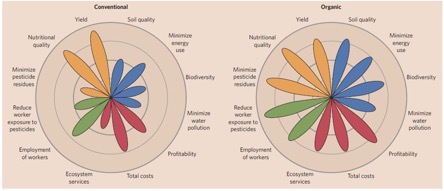
The first criticism can be easily answered: in fact, the real problem is not that organic food is too expensive, but that the non-organic food is hiding its real costs, which consumers nevertheless must pay. On one side, there are the negative effects on the environment (soils, water and air) of the food industry driven policy of producing food at low cost … no matter what the ultimate cost is (16). On the other, there are those on our health: the global cost of just diabetes in 2015 was estimated at US$ 1.31 trillion (17). In Italy, every patient suffering from diabetes costs today to the National Health System 2589 euros a year, and the diabetes-related therapies cost the Italian National Health System about 9% of the budget, or about 8.26 billion euros (http://www.istat.it/it/archivio/71090). In Africa, 35 million people – twice the number at present – will be affected by diabetes in the next 20 years (18)
The second criticism, that the productivity of organic farming is lower than that of conventional agriculture, on average between 8% and 25%, depending on the crop and the way in which organic farming is practiced, is used more often than the first to argue that with organic farming, many more people would suffer from hunger. What is the point of discussing such an agricultural system – it is being said – while we need to increase agricultural production by 70% or even 100% by 2050?
Recently the mathematical models, on which this second critique is based, have been questioned. First of all, when we discuss global agricultural production we forget about the enormous quantities of food that end up in waste, as much as 1.3 billion, equal to 30% of agricultural production (19). In addition to this, it is estimated that, globally, we produce about 4600 kilocalories/person/day: although 1400 are lost after harvest, during distribution and consumption, the 3200 kilocalories left are almost 1000 more than the 2360 kilocalories/person/day that according to the World Health Organization are sufficient for a healthy life (20). Thus the farmers of the world already produce around 50% more food than we need and, arguably, more than we will ever need.
Therefore, the supposed need to increase agricultural production by 70% or even 100% by 2050 is an overestimate. It is one deliberately used by institutions and individuals with a precise agenda regarding the problem of food security (21). In other words, these data are used to justify the need for pesticides and of biotechnologies, such as GMOs and, more recently, the gene editing that has aroused so much controversy.
What does science do?
We must not forget that, as previously stated, food derives from seeds and that therefore the primary cause of the health problems afflicting the world today can be sought in the way the seeds are produced. In addition, since the seeds are produced by plant breeding, to change things we have to rethink how plant breeding is done in order to move from “cultivating uniformity” to “cultivating diversity”.
Today, much of “institutional” plant breeding, and not only the private, has as its objective industrial agriculture (the only one that according to some will be able to feed the world), even though estimates are that family farms produce more than 80 percent of the world’s food in value terms (22). Institutional plant breeding is based on the selection, in one or few research centres, of uniform varieties – to oblige the seed laws we mentioned earlier – and oriented towards the use of fertilizers and pesticides.
Plant breeding programs specifically addressing organic farming are very limited in number (23). Therefore, one of the reasons for the difference in productivity between conventional agriculture and organic farming is that, in the latter, lacking suitable varieties, the same varieties are grown that are selected for conventional agriculture; these varieties find themselves in a completely different situation from the one for which they were selected, and therefore produce less.
This can be remedied quickly and inexpensively with evolutionary plant breeding—of which I am a practitioner (24). The method consists in creating plant populations by mixing seeds previously obtained by crossing different varieties, and letting them evolve using them as a crop or to select the best plants. This offers the possibility of adapting the crop both to long-term and short-term climate change, but also to control weeds, diseases and insects without resorting to pesticides. Thanks to the natural crossings that always occur within them, these populations evolve continuously (this is why they are called “evolutionary”) and the farmers have the opportunity to adapt the crops to their soil, their climate and to the particular way in which each of them practices organic farming.
The use of such populations, both in cereals and in some horticultural species, is spreading in Italy. Thanks to Rete Semi Rurali (http://www.semirurali.net/) there are projects in Sicily, Basilicata, Molise, Puglia, Abruzzo, Marche, Tuscany, Emilia Romagna, Veneto, Lombardy, Friuli-Venezia Giulia and Piedmont. The Italian Association for Organic Agriculture (https://aiab.it/) also is supporting this approach. These organisations support it because evolutionary plant breeding leads to seed sovereignty in its biological rather than ideological meaning, because for each farmer there cannot be better seed that the one produced in his/her own fields.
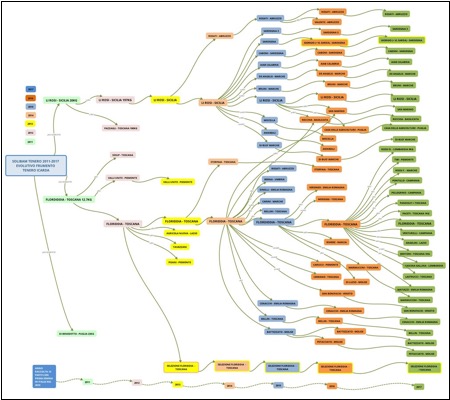
Evolutionary-participatory breeding is conducted in Sardinia by “Domus Amigas” (CSA) (www.domusamigas.it). In Emilia-Romagna, regional projects that experiment on mixtures are underway at the University of Bologna (http://www.bioadapt.eu/) and at the company OPEN FIELDS, (BIO2 Project (http://www.bioalquadrato.it/)). Studies on barley mixtures are currently underway at the Universities of Perugia (25), Bologna and Florence.
Experiences in Italy with an evolutionary population of over 2000 different types of bread wheat coming from all over the world, gives a bread that besides having an extraordinary smell and taste, is tolerated by people suffering from gluten intolerance: we propose to call this population “mixture of Aleppo” in recognition that it was constituted in Syria. In Iran, shepherds who have used the barley population as food for fed sheep have noted an improvement in milk quality. Recently, pasta was produced in Molise, with a population of durum wheat.
These results, which are receiving continuous confirmations, indicate that in addition to all the benefits already mentioned, the cultivation of evolutionary populations as such can represent the ideal way to combine food security with food safety, and at the same time to create income as demonstrated by the commercial success of bread made with the bread wheat population.
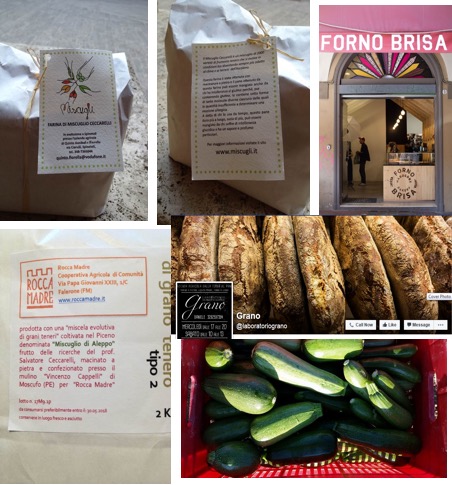
The use of plant populations in Europe has been made legal in the case of wheat, maize, rice and oats by the Commission. This implements its Decision of 18 March 2014 pursuant to Council Directive 66/402/EEC. With this Council Directive it is now possible to market experimental heterogeneous materials of the four different cereals up to 31st December 2018, which has just been extended to 2022. As a result, 34 plant populations have been registered and in a number of cases, their seed has been commercialized. The bright future of evolutionary plant breeding is a therefore a development of global significance.
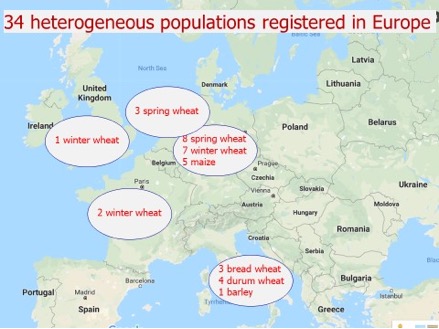
Salvatore Ceccarelli lives in Ascoli Piceno (Italy) and cooperates in organizing participatory and evolutionary programs with different organizations, with various crops and in a number of countries. He is associated with the organisation: Rete Semi Rurali, Via di Casignano, 25, Scandicci (FI) 50018, Italy (http://www.semirurali.net/) and with Bioversity International. His website is: http://www.miscugli.it/. His papers can be accessed by joining: https://www.researchgate.net/. (Stuffed and starved: The Hidden Battle for the World Food System is the title of an excellent book by Raj Patel).
Additional sources on evolutionary plant breeding:
https://www.feedingknowledge.net/home/-/bsdp/8737/en_GB
http://www.fao.org/plant-treaty/tools/toolbox-for-sustainable-use/details/en/c/1071318/
http://www.iao.florence.it/ojs/index.php/JAEID/article/view/28
http://www.mdpi.com/2071-1050/3/10/1944
https://www.plantagbiosciences.org/people/matteo-petitti/category/evolutionary-plant-breeding/
References
1. von Hertzen et al. 2011. Natural immunity: Biodiversity loss and inflammatory diseases are two global megatrends that might be related. EMBO reports 12: 1089-1093
2. The microbiome is the complex of micro-organisms and virus present in our intestine, while the microbioma refers more precisely to the genes of the microbiome
3. Khamsi R. 2015. A gut feeling about immunity. Nature Medicine 21: 674–676
4. Singh RK et al. 2017. Influence of diet on the gut microbiome and implications for human health. Journal of Translational Medicine 15 (1) :73
5. Gopalakrishnan et al. 2017. Gut microbiome modulates response to anti–PD-1 immunotherapy in melanoma patients. Science 02 Nov. 2017 : eaan4236
6. Hoban et al. 2016. Regulation of prefrontal cortex myelination by the microbiome. Translational Psychiatry 6, e774
7. Singh RK et al. 2017. Influence of diet on the gut microbiome and implications for human health. Journal of Translational Medicine 15(1):73
8. Rothschild et al.2018. Environment dominates over host genetics in shaping human gut microbiota. Nature 555: 210–215
9. Tilman D and Clark M. 2014. Global diets link environmental sustainability and human health. Nature 515 (7528): 518–522
10.Heiman and Greenway 2016. A healthy gastrointestinal microbiome is dependent on dietary diversity. Molecular Metabolism 5(5): 317–320
11. Thrupp LA 2000. Linking agricultural biodiversity and food security: the valuable role of agrobiodiversity for sustainable agriculture. International Affairs 76: 265 -281
12. Bonny S 2017 Corporate Concentration and Technological Change in the Global Seed Industry. Sustainability 2017, 9, 1632.
13. Mostafalou S, Abdollahi M. 2013. Pesticides and human chronic diseases: evidences, mechanisms, and perspectives. Toxicology and Applied Pharmacology 268 (2):157-77
14. Connor DJ 2008. Organic agriculture cannot feed the world. Field Crops Research, 106 (2): 187-190.
15. Reganold and Wachter. 2016. Organic agriculture in the twenty-first century. Nature Plants 2:15221.
16. Sukhdev P. et al. 2016. Fix food metrics. Nature 540: 33-34.
17. Bommer C et al. 2017. The global economic burden of diabetes in adults aged 20-79 years: a cost-of-illness study. Lancet Diabetes Endocrinology. 5 (6):423-430.
18. Jaffar S. 2016. Diabetes and other non-communicable diseases in Africa: a potential disaster in the waiting The Lancet 4 (11): 875–877.
19. FAO. 2011. Global food losses and food waste – Extent, causes and prevention. Rome.
20. Smil V 2000. Feeding the World: A Challenge for the Twenty-First Century. Cambridge, MA, USA: MIT Press.
21. Tomlinson I 2013. Doubling food production to feed the 9 billion: A critical perspective on a key discourse of food security in the UK. Journal of Rural Studies 29: 81-90.
22. FAO. 2014. The State of Food and Agriculture 2014. Innovation in family farming. Rome.
23. Campanelli et al. 2015. Participatory Tomato Breeding for Organic Conditions in Italy. Euphytica 204 (1) 179-197
24. Ceccarelli S. 2009. Evolution, plant breeding and biodiversity. Journal of Agriculture and Environment for International Development 2009, 103 (1/2): 131-145
25. Raggi L. 2017. Evolutionary breeding for sustainable agriculture: selection and multi-environment evaluation of barley populations and lines. Field Crops Research 204: 76-88.
If this article was useful to you please consider sharing it with your networks.



Isn’t that so called ‘evolutionary plant breeding’ a technique used by all the farmers for thousands of years, without that need of adding ‘evolution’ into the business??? Married couples blessed with a child never seen before, have nothing to do with ‘evolution’, this ‘process’ is called NATURE, CREATION.
As a research scientist, I have been in touch with Dr Ceccarelli many times, and always admired his broad knowledge of the relationships of genetics with the environment. The highly focused so-called “modern genetics” approaches are more oriented toowards patents and rapid profits, and less in touch with the broader biological reality, food safety, agriculture sustainability and the real needs of mankind.
There is an enormous need of research in organic agriculture; even if it is already viable, it could still gain a lot in efficiency. Indeed, it is a system that can not only feed the world, but reduce many modern diseases. My most sincere congratulations to Dr Ceccarelli for this excellent text; I wish it could have influence on world leaders.
I have admired Dr.Cecerelli for his quick responses to the intense discussion we have had with him. Though we are a small organisation in south of India we have benefitted a lot from discussions with him /we are still struggling to raise funds to do the kind of work we have seen Dr.Cecerelli does.
vanaja